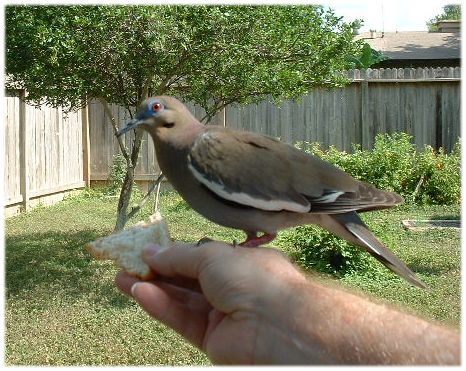(Document converted to web page on 29 Feb 04)

August 2002:
My wife and I have a large tree in our backyard. The tree has a horizontal bough about seven feet above the ground that turns upward over the roof of our house. Our bird feeder hangs from this bough, and we watch the birds through our bay window, from our den, and from our screened porch.
When I put sunflower seed in the feeder each morning and late afternoon, I also secure some raw peanuts (in their shells) to another bough above the feeder. In addition, I rub old bread into the rough bark on top of the horizontal bough. (I have to stand on a lawn chair to do that.) This food combination attracts various interesting birds: cardinals, woodpeckers, titmice, blue jays, chickadees, finches, etc.
I noticed that one white-winged dove often waited nearby on a limb for me to finish spreading the bread and remove myself and the lawn chair from the tree. It would then fly to the bough and start eating the bread before the other birds converged on the site. The pattern became routine, and I decided to conduct an experiment that lasted about two weeks.
One time, after spreading the bread on the bough of the tree, I remained standing on the chair to see what the dove would do. Sure enough, it flew to the bough and cautiously ate bread about two feet from my head. I continued this process for several days, and the dove began to feel more comfortable with my presence.
I tried the next step of the experiment by not spreading the bread on the bough. Instead, I held the bread between my fingers and rested my hand on top of the bough. The dove flew to the bough, but it was reluctant at first to eat from my hand. Finally, it would eat the bread from my fingers (with cocked wing to demonstrate uneasiness with this new routine).
The next step was to make it necessary for the dove to climb onto my hand to get the bread. It balked at my hand movements at first when I nudged it gently, but it wanted the bread bad enough to eventually pass the test. It took several days, but the dove decided my hand was okay to eat from, and this became the new routine.
The last thing I did to gain the dove's trust was to hold the bread in my hand away from the bough of the tree so it had to fly a foot or so to my hand to get the bread. After that, I increased the distance until he would fly from the bough to my hand while I stood on the ground away from the tree. (I told my six-year old granddaughter about this dove, and she named the dove "Raven," after a bird in one of her storybooks.)
Now, when I go outside to service the bird feeder, I feed Raven first by offering it a mixture of sunflower and millet seeds in the palm of my hand. Usually Raven waits for me and flies down to eat from my hand. Sometimes, when I'm working in the yard, he (or she) lands near my feet or hovers in front of me until I extend my hand for him to land on. When this happens, I usually provide him with a quick snack. (He landed on top of my head one time.)
I have other doves that feed in my backyard, at my feet, but Raven is the only
one that has crossed the line and allows contact feeding. Other types of birds tolerate my presence,
but none have shown any inclination to get too close to me. Perhaps Raven is a fluke and not very
bright. On the other hand, he always gets fed first and doesn't have to compete with the other birds for food, so he
might be plenty smart for a bird.
December 2002:
Raven stopped coming to my hand during the last couple of weeks. Since the doves all look alike to me, I don't
know if he's one of the others, or if a cat got him. Maybe he will turn up again in the spring.
1 April 2003:
Raven came back. Apparently a cat did not get him, and he was just wintering someplace else the last few months.
I was rubbing old bread into the tree bark, and he landed on the bough in front of
my face and started eating. I stepped down from the chair and got a handful of seed, and he wasted no time flying to
my hand and picking up where he left off last December.
February 2004:
I havenít seen Raven since last summer. He might be eating my seed with the other birds, but he no longer makes his presence obvious. Perhaps heís all grown up now and canít mingle with humans because his mate has given him new direction. Whatever his fate, I miss his company when doing my chores in the backyard.
Paul Proft
© 2002-2004
About white-wing doves
More hand-fed birds: Missy Starlene Peeps